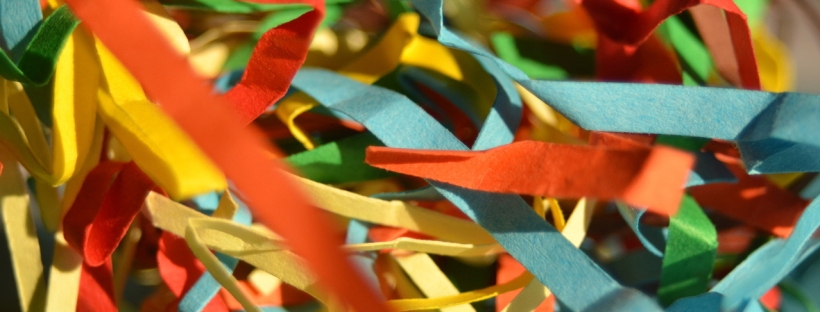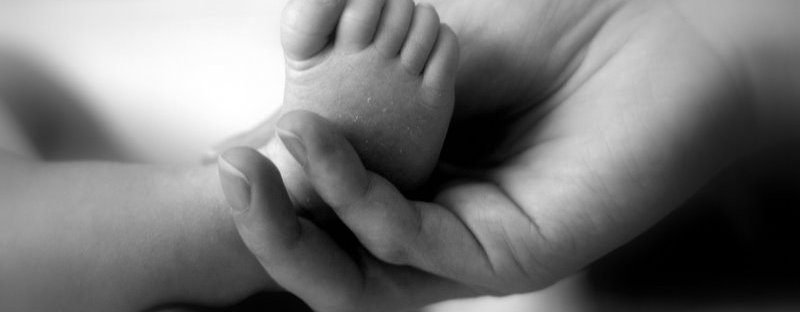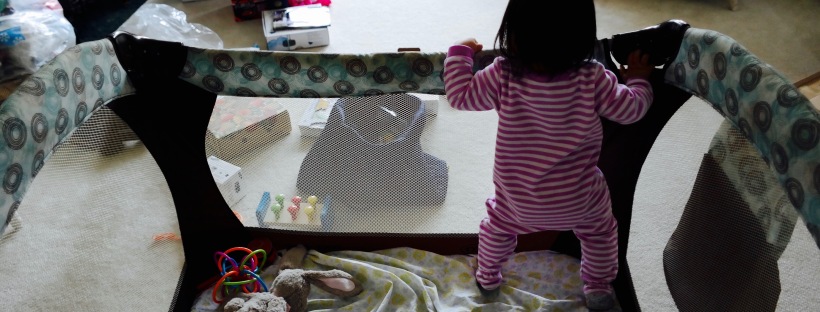Put paper into a shredder if you have one. Otherwise, cut paper into long thin pieces. You can use a variety of paper. For instance, construction paper, printer paper, magazine sheets, scrap paper, or newspaper. Then put it all in a tub where he can play away. He will be transfixed with pulling the paper apart and feeling how it crumples together.
Category: 6-9A
Water Paper Baby Activity
This is a simple activity that captivates little ones. It usually is the simple ones. Grab a tub and fill it with water. Grab different types and sizes of paper and stack it next to the tub. Example paper types: printer paper, scratch paper, notes, magazine pages, or construction paper. Watch as she dips, pushes, and soaks the paper in the water. After awhile of play, you can add a new element by giving her child friendly tongs, spoons, ladels, or cups to poke, scoop and play with the paper.
Dry Pasta Sensory Baby Activity
Go to the store and pick out different color and shaped pasta. There are spiral, shells, macaroni, or wheels to name a few kinds. Next, dump a bit of each kind in a baking dish or tub and let her explore all the different shapes! Watch so she does not put the pasta in her mouth.
Power of Touch Baby Activity
In one study, 4 month olds who received an 8 minute massage performed better on early memory and sensory skills tests. Ideas on baby massage:
- Make sure the environment has no additional stimulus in the background (aka TV) and that the temperature of the room is warm and comfortable for him. You ideally want skin-to-skin contact. If comfortable with using, you can use small amounts of oil for massaging, such as vegetable oil. Aim to massage for 8 minutes at least.
- Start by massaging her head very gently- do not apply too much pressure in this area. Try massaging in lines down her muscles of her arms and legs and circular movements over her joints. Then gently extend her arm and leg at the end of her massage. Rub her belly gently in the direction of her colon- clockwise. Aim for at least an 8 minute massage.
Engagement Baby Activity
Babies and young children naturally get bored. They were born that way! Have you noticed they don’t seem as interested in the same toy or the same game when it has been done repetitively? Keep things interesting by changing it up! Draw their focus to other aspects of the toy or game. By encouraging their attention, you begin to lay the groundwork for perseverance, motivation and focus- all necessary life skills. Here are ways to stimulate these characteristics.
What’s New Here? Rotate her toys! Try rotating in new toys every week or two. Only a handful is necessary- you don’t have to completely change all of her toys. When we say new, we don’t mean brand new either! Just toys she hasn’t seen for a bit and are “new” to her today. You can keep rotating in and out with the toys she already has!
Old Toy, New Toy! The same toy can seem novel and new in a new environment! It is that easy to shake things up! Place a few of her favorite toys in a new place- the car, bathroom, kitchen, grandma and grandpa’s house are just a few examples. Take her hairy gorilla, put curlers in its hair, and put it in front of Mom’s makeup counter.
It’s in the Details. Focus on different uses of a toy or different characteristics of the toy. “Wow, this horsey can suddenly fly!” “Look how I can spin the rattle!” “I like the triangle pattern on this toy!” Or, if you always play with her a certain way, spice it up! Always move her legs? Move her arms too or move her legs in various ways. Always throw and catch her up in the air? Try swinging her from side to side instead.
Molding Tastes Sensory Baby Activity
It’s pretty much all environmental when it comes to developing our taste preferences. Our hereditary genes have just a smidgen of a factor. So, you as parents have a huge impact on your kids’ natural food choices and what they will like or not like to eat.
Try a new vegetable and fruit this week! Maybe it’s garlic spinach, acorn squash mixed with nutmeg, or sautéed yellow squash and onions as your new veggie of the week. For fruit, try kiwi, mango, or blueberries (make sure they are ripe). If they do not eat it on the first try, it doesn’t mean they do not like it. It just means they are not used to it. Try this same vegetable and fruit again later this week and repeat tries 3 weeks in a row!
See, Reach, Touch Infant Activity
Your baby has been rigorously practicing reaching and grabbing, and with all the swatting at toys, they have finally been able to successfully reach and grab (on average starts around 4-5months)and maybe even do this consistently and in a very controlled fashion(starts around 6-7months). Continue to let them hone their skills through fun practice of reaching for what they want. This also stimulates their sense of vision and touch!
Offer a variety of objects that differ in size, shape, and texture. Let her feel what it is like to hold a smooth ball versus an object with corners; a small toy that she can easily hold in one hand or a larger toy requiring to use two hands; a toy that has different parts that dangle versus a solid object, to name just a few examples. Be careful not to overwhelm her with too many toy options. Pick 3-5 toys on which she can focus. Who knows, she may even reach for 2 toys for each hand!
3-9M
Peek-a-Boo Baby Game
Engage your baby with simple play and language learning just happens!
Use a soft cloth and gently cover his eyes. You can say: “Where’d baby go?!” Then lift up the cloth and smile big and say “Oh! There you are silly!” Repeat and watch your baby giggle!
Pincer Grasp Baby Activities
Depending on your baby, can maybe try these activities as young as 6 months. Usually around 9 months, however, is when the pincer grasp may first be developing.
Baby is a pro at reaching and grabbing what they want! The next fine motor milestone programmed in their DNA, is the pincer grasp- grabbing with the thumb and finger. Before they may have successfully grabbed small objects by scooping and tightly grabbing with their palm. But now, they will realize and practice the finer movement of grabbing with their fingers. You can help them along with this motor skill development by fun play activities to introduce and refine the pincer grasp.
Your baby loves to squeeze, push and pull things apart. Luckily, this helps her strengthen those little muscles of her hand.
- Let her squirt and squeeze those bath toys
- Squeeze squishy balls
- Play with Mega Blocks
- Embed toys in playdoh and have her pull them out
The act of pointing or poking is a great first step. It helps isolate that pointer finger.
- Play with your baby and ask her to point at birds or planes she sees; point at pictures in books; or point at cheerios on her plate. Take at least 5 minutes to do this
- Push holes in play dough, the rug or carpet or squish food. Take at least 10 minutes to do this
- Poke at toys with buttons, holes, or switches. Take at least 5-10 minutes to do this
Pulling to Stand
Your baby may be pulling to a standing position at this point. They may or may not be crawling or cruising yet, but they use their arm muscles and begin to pull their body up as their legs push down. Here is a way to help your baby along the way.
You can help your baby by activating his body through touch to let him learn the appropriate sensations necessary for an optimal stance. Lay him down and take one heel. With your thumb, firmly press on the center of his heel. Repeat a few times and then do the other heel. This physical therapy technique helps at any stage, regardless if the baby is at the cusp of pulling to stand or already pulling to stand. The touch associated with his heel will teach his body to learn an appropriate standing position that gives him an optimal chance of power in his legs and balance.
8-12 Months









